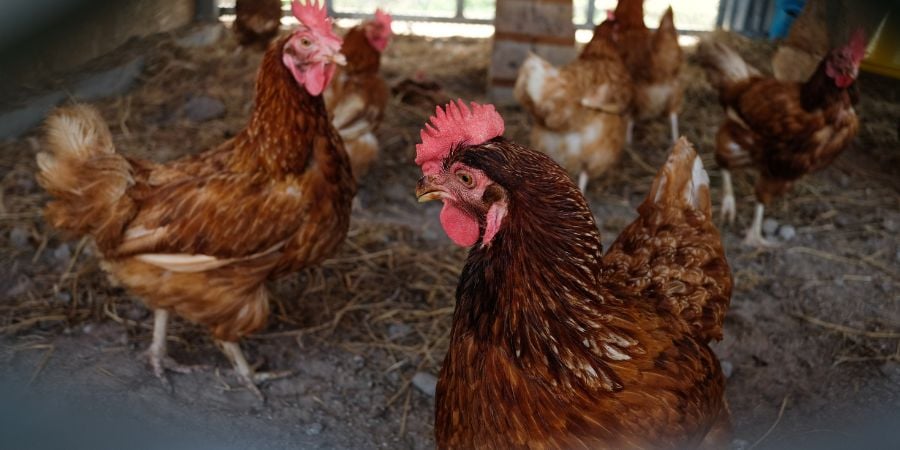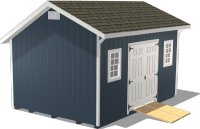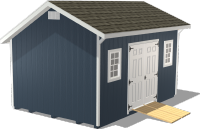Elevated Chicken Living: High-quality Coops for Superior Comfort & Style
by Dakota Storage Buildings, on November 29, 2023

Elevating the comfort and style of your backyard chicken coops is about more than just aesthetics — it directly affects the well-being and productivity of your flock. A coop, after all, is not merely a house; it is a haven that impacts egg-laying, movement, and safety. So, how do you navigate the myriad of options available, especially when prioritizing both chicken comfort and aesthetic appeal? Whether you are starting out with a new flock or looking to upgrade your current setup, this blog will give you insights into determining the appropriate size, ensuring the utmost safety, and creating a delightful oasis in a high-quality coop.
Coops and Comfort: Crafting the Ideal Home for Your Chickens
When it comes to chickens, their housing plays an indispensable role in determining their overall health, behavior, and even productivity in terms of egg-laying. Many chicken keepers are now moving away from traditional pens in favor of backyard chicken coops, and for good reason. Coops provide a sanctuary — a safe and controlled environment protecting your chickens from unpredictable weather patterns, whether it is the scorching heat of summer or the biting cold of winter. Coops also play a significant role in safeguarding them against predators, both from the ground and the sky. It is a space where they can roost in peace, lay their eggs without stress, and enjoy some degree of freedom.
Investing in a coop built from the finest materials is not just about longevity or sturdiness, though those are essential factors. It is about creating an environment where chickens feel secure and happy. The kind of wood, the spacing between slats, the insulation — all these factors make a difference in the day-to-day life of a chicken.
If you are on the fence about whether to invest in a pre-built coop or delve into the world of DIY chicken coop building, it is vital to weigh the pros and cons of each. While pre-built coops offer convenience and professionally designed aesthetics, building one yourself allows for personalization and can be tailored to your flock's unique needs. Whichever route you choose, the key is to prioritize quality and functionality alongside style, ensuring that your chickens have a residence that is both cozy and chic.
Balancing Size, Safety, and Comfort for Your Flock

Selecting the appropriate size for your backyard chicken coops is not simply about the space; it is about ensuring that the environment allows for growth, movement, and comfort. A coop that is too small can lead to stress, feather pecking, reduced egg production, and even disease due to the close proximity of the birds. On the flip side, a too-large coop can make chickens feel unsafe, as they instinctively prefer close quarters at night to maintain body warmth and feel protected.
Understanding Space Requirements
Every chicken, based on its breed and size, requires a specific amount of space to thrive. At the same time, Bantam breeds might be smaller and need less room; larger breeds like the Rhode Island Red or the Plymouth Rock demand more spacious accommodations. Additionally, while they might roost closely at night, they require ample space to move, forage, and express natural behaviors during the day.
Sizing Guide
Small Flocks (less than 15 chickens): For those just beginning their poultry journey or with limited backyard space, small flocks are manageable and delightful. For small flocks, a coop size of 30 to 60 square feet often suffices, offering each bird the comfort they need.
Medium Flocks (around 25 chickens): As your love for poultry grows, so might your flock. Medium-sized coops offer the perfect balance between manageability and scale. For about 25 chickens, aim for a coop size that is between 50 to 100 square feet, ensuring every bird has sufficient space.
Large Flocks (40 chickens and above): Managing larger numbers means more responsibility in terms of coop size. An 80 to 160-square-foot coop is recommended. If you have a particularly expansive flock, considering multiple coops or a segmented design might be beneficial. This allows for easier management, especially if you have birds of varying ages or breeds.
Guarding Your Feathered Friends: Ensuring Flock Safety
Safety is paramount when it comes to raising chickens. Beyond providing a haven for laying eggs or roosting, your coop serves as the primary line of defense against potential threats. As docile and vulnerable creatures, chickens attract a variety of predators that vary based on your location — from cunning foxes in rural areas to curious raccoons in suburban settings.
Recognizing Predators
Before fortifying your coop, it is essential to understand the potential threats in your region. While rural areas might contend with larger predators like coyotes, urban and suburban locations often see smaller yet equally crafty predators like raccoons, weasels, or even birds of prey. Each predator has its own tactics; some might dig under fences, others might pry open latches, and aerial predators could swoop down from the sky.
Fortification Techniques
Robust Fencing: Heavy-duty wire mesh is far superior to chicken wire. While chicken wire keeps chickens in, it does not necessarily keep predators out. A raccoon can easily tear through chicken wire. Opt for hardware cloth with a tight mesh, ensuring it's buried at least a foot deep around the coop to prevent digging predators.
Secure Latching Systems: Raccoons are known as the "primates of the rodent world" due to their problem-solving capabilities. Simple latches might not deter them. Invest in complex latches or even padlocks. Automatic door systems, which close at dusk and open at dawn, can also be a game-changer.
Aerial Defense: Netting or wire mesh over open outdoor areas can deter birds of prey. Ensure that the gaps are small enough to prevent owls or hawks from making their way in.
Coop Design for Safety
Elevated Coops: Raising the coop off the ground can deter some ground-based predators and pests.
Solid Flooring: Some predators might try to burrow into the coop. A solid or reinforced floor can provide an added layer of protection.
Window and Vent Protection: Windows and vents are essential for ventilation but can be weak points of entry. Secure them with the same heavy-duty mesh used for the coop's exterior.
Regular Maintenance and Checks: Safety is not a one-time effort. Regularly inspect the coop for signs of wear, tear, or potential weak points. Look out for signs of attempted intrusion, like dug-out areas or tampered latches. Being proactive and addressing vulnerabilities promptly can make all the difference.
High-quality Backyard Chicken Coops Turned to High-quality Living

When we think of high-quality living, images of luxurious spaces, well-maintained surroundings, and a comfortable environment come to mind. The same principles apply when considering a chicken's living conditions. Like us, they thrive in environments that cater not only to their basic needs but also to their well-being and contentment.
The Importance of Material Choice
Wood — The Preferred Choice: While various materials could be used to build a coop, high-quality untreated wood stands out. It is because of its natural aesthetic appeal and because wood offers excellent insulation properties, keeping the coop warm in winter and cool during summer.
Weatherproofing: High-quality living is not just about the here and now but ensuring longevity. Using weather-resistant paints and treatments can increase the lifespan of your coop, ensuring your chickens have a comfortable home for years to come.
Beyond the Coop
Foraging and Free Range: Chickens are natural foragers. Providing them with a varied landscape filled with bugs, greens, and grains will keep them entertained and ensure a more balanced diet. The scratching and pecking actions are essential for their mental well-being.
Special Areas for Dust Baths: A sandy or dusty corner where chickens can indulge in their dust baths is more than a luxury — it is a necessity. Dust baths help chickens rid themselves of mites and other pests, keeping their feathers pristine.
Herbal Delights: Planting herbs like lavender, mint, and rosemary can be dual-purpose. Chickens occasionally nibble on these, benefiting from their medicinal properties, and these herbs can act as natural insect repellents.
Cleanliness Equals Healthiness
Clean water is a basic need. Beyond having a simple water dispenser, consider adding a small pond or a consistent dripping system. These systems ensure a constant supply of fresh water and offer chickens a chance to play and cool down, especially during hotter months.
Keeping the coop clean is crucial for the health of your flock. Regularly changing bedding, cleaning out feeders and waterers, and ensuring that the coop remains dry will prevent the onset of diseases. As a bonus, the collected manure can be turned into rich garden compost.
Your Chickens Deserve the Best: Tips for Choosing the Right Coop
Securing the perfect backyard chicken coop is all about striking a balance to ensure safety while allowing your chickens to thrive. When you choose the right coop, it reflects the love and care you have for your flock. Remember, contented and stress-free chickens are more likely to lay regularly, live healthily, and add vibrancy to your backyard environment. If you want to dive deeper and find out which chicken coop is the perfect home for your flock, be sure to download our comprehensive guide, ”Evaluating the Best-fit Quality Chicken Coops.” With the right knowledge and tools, you can find that high-quality coop that is the perfect fit for your beloved flock.

























